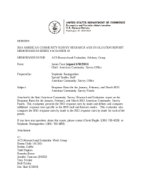Response Rates for the January, February, and March 2013 American Community Survey Panels
Response Rates for the January, February, and March 2013 American Community Survey Panels
Beginning in January 2013, the American Community Survey (ACS) introduced an Internet response option for respondents along with a new mailing strategy. Each month, all sample addresses with a complete mailing address receive information on how to access the Internet instrument to provide their response to the ACS. If we do not receive an Internet or telephone questionnaire assistance (TQA) response from the address after about two weeks, the address receives another mailing that includes a paper questionnaire. Respondents then have the choice to either access the Internet to provide a response, complete the paper questionnaire and mail it to the National Processing Center (NPC) for data capture, or provide a response via TQA. Addresses that respond by Internet, mail, or TQA constitute self-response in 2013, which is comparable to mail or TQA response in 2012 and earlier. The term "self-response" indicates that the respondent took the initiative to provide a response as opposed to the interview-administered responses received from nonresponding addresses during the Computer-Assisted Telephone Interview (CATI) and Computer-Assisted Personal Interview (CAPI) operations. This report compares the following response rates for the January, February, and March panels:
- The 2012 mail response rate to the 2013 self-response rate (mail and Internet responses combined)
- The 2012 CATI response rate to the 2013 CATI response rate
- The 2012 CAPI response rate to the 2013 CAPI response rate
- The 2012 overall survey response rate to the 2013 overall survey response rate
In addition, this study will present response rates that are specific to the 2013 mail and Internet modes. The Census Bureau releases information about mode specific response in other formal documentation. Each year, the Decennial Statistical Studies Division (DSSD) produces the official response rates by mode. We used the same definitions in this evaluation that are used in producing those official response rates. For this reason, the 2012 rates computed as part of this evaluation are identical to the officially produced 2012 response rates (Cyffka, 2012) and we expect the 2013 rates computed as part of this evaluation to be consistent with the official 2013 response rates that DSSD will release later this year. The rates in this report that are specific to the 2013 Internet mode differ from rates presented in Davis, 2014. Those Internet self-response measures consider responses from the first month of data collection only and therefore overstate final Internet self-response that we present in this report.
Others in Series
Working Paper
Working Paper
Working Paper




